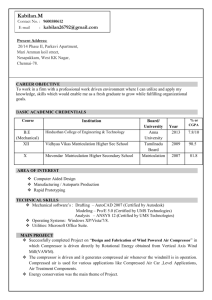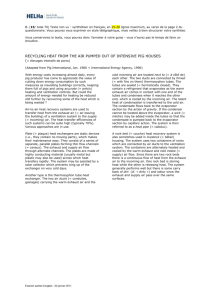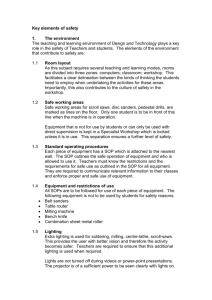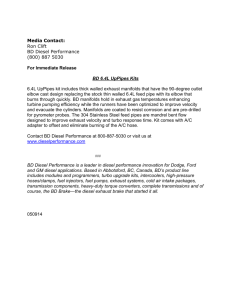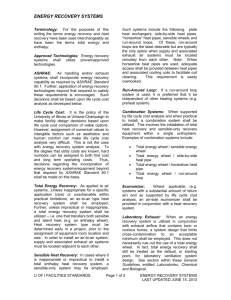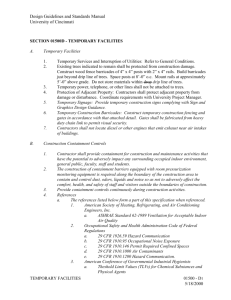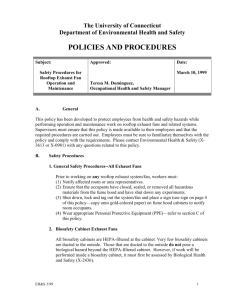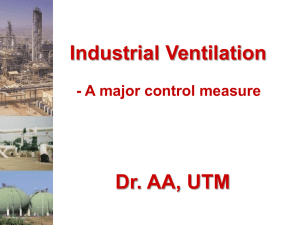pharmaceutical canine
advertisement
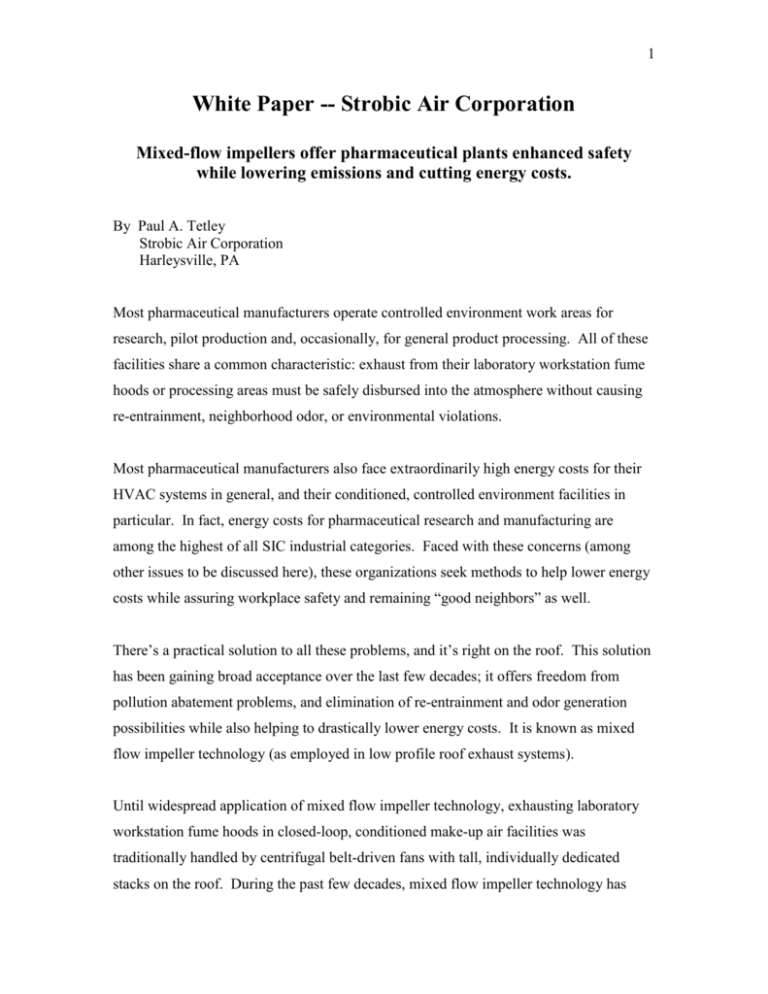
1
White Paper -- Strobic Air Corporation
Mixed-flow impellers offer pharmaceutical plants enhanced safety
while lowering emissions and cutting energy costs.
By Paul A. Tetley
Strobic Air Corporation
Harleysville, PA
Most pharmaceutical manufacturers operate controlled environment work areas for
research, pilot production and, occasionally, for general product processing. All of these
facilities share a common characteristic: exhaust from their laboratory workstation fume
hoods or processing areas must be safely disbursed into the atmosphere without causing
re-entrainment, neighborhood odor, or environmental violations.
Most pharmaceutical manufacturers also face extraordinarily high energy costs for their
HVAC systems in general, and their conditioned, controlled environment facilities in
particular. In fact, energy costs for pharmaceutical research and manufacturing are
among the highest of all SIC industrial categories. Faced with these concerns (among
other issues to be discussed here), these organizations seek methods to help lower energy
costs while assuring workplace safety and remaining “good neighbors” as well.
There’s a practical solution to all these problems, and it’s right on the roof. This solution
has been gaining broad acceptance over the last few decades; it offers freedom from
pollution abatement problems, and elimination of re-entrainment and odor generation
possibilities while also helping to drastically lower energy costs. It is known as mixed
flow impeller technology (as employed in low profile roof exhaust systems).
Until widespread application of mixed flow impeller technology, exhausting laboratory
workstation fume hoods in closed-loop, conditioned make-up air facilities was
traditionally handled by centrifugal belt-driven fans with tall, individually dedicated
stacks on the roof. During the past few decades, mixed flow impeller technology has
2
made significant inroads for many of these applications. Recently, this technology has
become even more popular, mainly as a result of its ability to capture ambient heat within
a controlled environment facility prior to its discharge into the atmosphere. This
capability alone has resulted in savings of tens and even hundreds of thousands of dollars
annually for pharmaceutical organizations throughout the country – especially those
located in colder climates.
Exhaust stream dilution prevents re-entrainment
Mixed flow impeller roof fans send their exhaust streams hundreds of feet into the air in a
powerful vertical plume, mixing outside air with exhaust gases (dilution) to prevent reentrainment as well as eliminate odor problems. They also provide other advantages,
such as inherently lower energy consumption over comparable centrifugal-type exhaust
systems. With the ability to pre-heat (and pre-cool) makeup air prior to its introduction
into the building, the systems permit substantial energy savings for pharmaceutical
research and manufacturing organizations.
Roof exhaust systems at pharmaceutical processors perform many different functions.
Their mail purpose is to prevent re-entrainment to help assure healthy indoor air quality
(IAQ), since there have been problems over the past few years as a result of poor IAQ. In
fact, there have been cases where employees became ill because exhaust was re-entrained
through building intake vents, doors, windows, and other openings.
While roof exhaust re-entrainment can be a serious problem, all of its negative
implications may not be widely known. Not only can the health of building workers be
affected by exhaust reentering the building, but the legal consequences can extend well
beyond their employers. There have been cases where building owners, consulting
engineers, heating, ventilation, and air conditioning (HVAC) contractors and even
architects were named as defendants in major cases associated with employee illness and
IAQ.
3
Research laboratories at most pharmaceutical organizations can range from discrete
prototyping facilities through complex biosafety level (BSL) 3 or 4 facilities which
require accurate, repeatable control and management over such environmental parameters
as temperature, pressure, airflow, and humidity – almost always in combination. Roof
exhaust re-entrainment at biosafety level laboratories may be insidious at times – but can
be serious. This is especially true at BSL-3 and -4 laboratories where highly contagious
microorganisms may be present. No matter what kind of research is being conducted, it
is imperative that the workstation fume hood exhaust system be given proper
consideration. Exhaust re-entrainment can be caused by many factors such as inefficient
roof fans, poor exhaust stack design and/or location, position of building air intakes,
weather and wind conditions, and other factors which will be discussed here.
BSL laboratories present a unique set of problems with regard to re-entrainment and
pollution abatement. As a result they are governed by rigid codes and standards (in some
instances guidelines only) formulated by a number of organizations including the
American National Standards Institute (ANSI), American Industrial Hygiene Association
(AIHA), National Fire Protection Association (NFPA), National Research Council
(NRC), American Conference of Governmental Industrial Hygienists (ACGIH),
American Institute of Architects (AIA), Occupational Safety and Health Administration
(OSHA), American Society of Heating, Refrigeration and Air conditioning Engineers
(ASHRAE), the Center for Disease Control (CDC), the National Institutes of Health
(NIH), and the U.S. Department of Health and Human Services (DHHS).
Special exhaust requirements at BSL laboratories
Biosafety level laboratories (mainly levels 3 and 4) must incorporate many special design
and engineering features to prevent microorganisms from being discharged into the
environment. These features would typically include specially shielded isolation rooms
under negative pressure with sophisticated control and monitoring systems for managing
their environmental parameters; they would also require 100% conditioned “makeup” air
to prevent re-use of the ambient air within an enclosed facility.
4
Obviously exhaust emissions from laboratory workstations at these facilities must be
treated carefully. For one reason, they may be highly toxic or noxious – or both. Their
danger to people covers a broad spectrum which might be mildly annoying to seriously
unhealthy. Even if the exhaust stream does not present health issues, public tolerance for
annoying odors has sharply decreased in recent years, partly because government
agencies are continually setting more stringent standards and lowering allowable
exposure limits. Obviously there is no room for tolerance with regard to possible
contamination from some agents that are exhausted at BSL Level 3 and 4 facilities.
HEPA filter modules reduce dust emissions
As in most pharmaceutical research laboratories and pilot processing areas, a dedicated
air supply and exhaust system is critical to safety as well as comfort. The HVAC system
would typically be independent of all other supply and exhaust systems within the
building. Because of increasingly stringent environmental regulations, mixed flow
impeller systems incorporating bag-in/bag-out (BIBO) High Efficiency Particulate Air
(HEPA) modules and filters are also becoming popular for research, pilot plant, and
production environments. The modules are typically matched with application specific
filter media which accommodate a variety of HEPA and ASHRAE filter efficiencies.
Mixed flow impeller systems with HEPA modules and filters are particularly useful at
pharmaceutical processing organizations, since unwanted dust is created during the
manufacturing and packaging cycle. Sources for this dust vary. They can include
formulating tablets or capsule ingredients from powders, spray coating tablets, drying
products (which creates particulate fines through airstream abrasion or contact friction)
and even packaging when tablets are transported at high speeds on conveyor lines or
capsules are being filled by automated equipment.
Heat recovery saves thousands of dollars yearly
With regard to the extraordinarily high energy costs faced by most pharmaceutical
organizations, there appears to be no cap in sight. In fact, based on an extremely unstable
geopolitical climate among many energy producing nations, it would be surprising to see
5
significant cost reductions in the future. To that end most prudent pharmaceutical
processors seek new ways to reduce their energy costs. Mixed flow impeller technology
has proved to be beneficial for these organizations where conditioned air must be filtered,
heated, cooled, humidified, or de-humidified (or some combination) depending upon
requirements.
These organizations must provide comfortable and safe environments for scientists and
technicians, and that requires efficient – and expensive – heating and cooling of makeup
air for the workplace. In addition, workstation fume hoods usually require sophisticated
controls and energy consuming hood management equipment for proper operation.
When you add fume hood exhaust systems on the roof – which must operate whenever a
workstation is being used – energy costs mount up quickly.
Mixed flow impeller technology represents an ideal solution to these problems. By
adding accessory heat recovery modules consisting of glycol/water filled coils that
extract heat from workstation fume hood exhaust before it is discharged above the
roofline, substantial energy savings are realized. The warm air from the heat exchanger
is transferred to the supply side handler to preheat the conditioned air entering the
building, thus reducing the amount of natural gas or fuel oil needed to heat makeup air.
This process works the same way for chilled air, of course.
3% energy savings for each 1° F temperature increase
Mixed flow impeller exhaust systems with heat exchanger coils save about 3% of energy
costs for each 1° F rise in recovered heat; similar, but not quite as dramatic, savings are
realized for cooling applications. Systems such as these are most practical when outside
air temperatures are below 40° F (5° C) or above 80° F (27° C) typically. That’s because
there must be a large enough difference between outside and inside air to make it costeffective. On the cooling side, if the outside air temperature is 90° F (32° C) and the
chilled indoor air is sent through the heat recovery coils, the makeup air temperature drop
is typically 4° to 5° F.
6
As anti-pollution laws become tougher, even the sight of a tall exhaust stack on the roof
imparts negative connotations in a community. Also, tall exhaust stacks usually require
complex, expensive mounting hardware (elbows, flex connectors, spring vibration
isolators, guy wires, roof curbs, etc.), and often still do not totally prevent re-entrainment
of exhaust fumes back into the building or adjacent facilities. In addition, the belt-driven
centrifugal fans associated with these systems require regular maintenance; because of
this they are often housed on the roof inside a “penthouse.” The penthouse protects
workers from the elements during maintenance operations; however, these workers might
also be subject to exposure from toxic and/or noxious fumes, since the fans’ discharge is
always under positive pressure.
Reduced installation costs, less maintenance problems
Roof exhaust systems incorporating mixed flow impeller technology eliminate nearly all
of these problems. Their low profile design (typically about 15' high) eliminates the need
for all structural reinforcements on the roof. Because they are substantially shorter (and
constructed modularly) than the tall, often unsightly stacks they are used to replace, their
simplicity also helps reduce installation time and costs significantly. In fact, in many
retrofit applications there is virtually no downtime associated with their installation.
Under normal conditions, mixed flow impeller systems are designed to operate
continuously for years without maintenance. Direct drive motors have lifetimes of L10
400,000 hours (see sidebar). And the non-stall characteristics of the blade design permits
variable-frequency drives to be used for added variable-air-volume (VAV) savings, builtin redundancy, and design flexibility. These fans also operate at lower noise levels than
centrifugal fans – particularly in the lower octave bands – which could be advantageous
in some locations. When noise is still an issue, however, accessories such as low profile
acoustical silencer nozzles can be used.
Low operating costs help the bottom line
Mixed flow impeller fans typically consume about 25% less energy than conventional
centrifugal fans, and offer faster payback periods as well. Typical energy reduction is
7
$0.44 per cubic foot per minute (CFM) at $0.10/kilowatt-hour, providing an approximate
two-year return on investment. These numbers do not include the drastic energy savings
they can provide for conditioned makeup air facilities.
Building aesthetics should also be considered
When designing or retrofitting a new roof exhaust system stack height should also be
considered as well for performance (re-entrainment prevention and pollution abatement),
aesthetics, and code/standard compliance. Ideally you would seek the lowest profile
possible which not only eliminates the “smoke stack” pollution generating negative
connotations perceived by many people, but it may also help conform to applicable
architectural/aesthetic ordinances. Elimination of tall, unsightly stacks which are either
prohibited by code or undesirable is an added benefit. In some areas for example, no
stacks are allowed on the roof – period.
Conclusion
There are hundreds of pollution control standards that must be addressed when
considering dedicated roof exhaust systems. Mixed flow impeller technology has proved
over the past few decades its value with regard to aiding conformance to virtually all
appropriate standards.
If you’re planning to upgrade, retrofit, or construct new laboratory workstation facilities
or process areas, mixed flow impeller technology exhaust systems represent a practical
and cost-effective approach for eliminating re-entrainment, preventing pollution and
neighborhood odor, conforming to aesthetic ordinances and standards, and cutting energy
costs substantially. In addition to dramatic fuel savings for heating and cooling (in 100%
conditioned makeup air facilities), this technology offers advantages of lower energy
consumption over comparable centrifugal-type exhaust fans, and virtual elimination of
periodic maintenance headaches. Based on current trends, this technology will likely
continue to meet the needs of a growing base of pharmaceutical research and
manufacturing organizations.
8
About the Author:
Paul A. Tetley is vice president and general manager at Strobic Air Corp., a subsidiary of
Met-Pro Corp. Since joining the company in 1989 as engineering production manager, he
has designed and/or invented Tri-Stack fan systems, an acoustical silencer nozzle, and a
unique multi-fan plenum system. He may be contacted at 215-723-4700 or by email at
ptetley@strobicair.com.
Sidebar 1: Characteristics Of
Mixed Flow Impeller Technology Systems
Mixed flow impeller systems operate on a unique principle of diluting contaminated
exhaust air with unconditioned, outside ambient air via a bypass mixing plenum. The
resultant diluted process air is accelerated through an optimized discharge
nozzle/windband where nearly twice as much additional fresh air is entrained into the
exhaust plume before leaving the fan assembly. Additional fresh air is entrained into the
exhaust plume after it leaves the fan assembly through natural aspiration effect. The
combination of added mass and high discharge velocity minimizes the risk of
contaminated exhaust being re-entrained into building fresh air intakes, doors, windows,
or other openings.
As an example, a mixed flow fan moving 80,000 cfm of combined building and bypass
air at an exit velocity of 6300 feet per minute can send an exhaust air jet plume up to 120
feet high in a 10 mph crosswind. This extremely high velocity exceeds ANSI z9.5
standards by more than twice the minimum recommendation of 3000 fpm. Because up to
170% of free outside air is induced into the exhaust airstream, a substantially greater
airflow is possible for a given amount of exhaust – providing excellent dilution
capabilities and greater effective stack heights over conventional centrifugal fans without
additional horsepower.
Mixed flow impeller systems also reduce noise, use less energy, and provide enhanced
9
performance with faster payback over conventional laboratory fume hood exhaust
systems. A typical reduction of $.44 per cfm at $.10/kilowatt-hour provides an
approximate two year R.O.I. Energy consumption for mixed flow fans is about 25%
lower than conventional centrifugal fans with substantially reduced noise levels,
particularly in the lower octave bands. They also conform to all applicable laboratory
ventilation standards of ANSI/AIHA z9.5 as well as ASHRAE 110 and NFPA 45, and are
listed with Underwriters Laboratory under UL 705.
Mixed flow systems are designed to operate continuously with a minimum amount of
required maintenance, providing years of trouble free performance under normal
operating conditions. Direct drive motor bearings have lifetimes of l10 400,000 hours.
(this refers to a “sample” of 100 motors in which the bearings in ten motors {10%}
would fail within a 400,000-hour timeframe. It is a baseline for comparison of motor
bearing lifetimes.) Non-stall characteristics of the system’s mixed flow wheel make it
ideally suited for constant volume or variable air volume (VAV) applications, along with
built-in redundancy, and design flexibility. VAV capabilities are achieved via the bypass
mixing plenum or by using variable frequency drives to provide optimum energy savings.
Virtually maintenance free operation (there are no belts, elbows, flex connectors, or
spring vibration isolators to maintain) eliminates the need for expensive penthouses to
protect maintenance personnel under adverse conditions. Consequently, additional
savings of several hundreds of thousands of dollars may be realized in a typical
installation.
Mixed flow impeller systems are available with a variety of accessories that add value,
reduce noise, and/or lower energy costs substantially. For example, accessory heat
exchanger glycol/water filled coils for use in 100% conditioned makeup air (controlled
environment) facilities add exhaust heat to intake ventilation air to save thousands (or
hundreds of thousands) of dollars in annual energy costs.
10
Sidebar 2: Biosafety Considerations
Biosafety laboratory levels are graded from 1 to 4, with many different standards and
guidelines set by the organizations mentioned in the accompanying text. These
organizations mandate guidelines that identify and list specific agents as to classes of
laboratories required for their presence. The different levels are essentially determined
by the degree of risk associated with exposure to various infectious agents within the
laboratories. For example, Level 1 agents are usually not placed on the list but are
assumed to include all fungal, viral, rickettsial, chlamydial, and parasitic agents which
have not been included in higher biosafety levels. For the most part these agents can be
handled safely in the laboratory without special equipment using techniques generally
acceptable for non-pathogenic materials. Typical examples include certain influenza
strains, infectious canine hepatitis viruses, and other “low-risk oncogenic viruses,”
according to the University of California, San Diego Biosafety Handbook.
Biosafety Level 2 bacteria are considered of “moderate potential hazard to healthy human
adults and the environment.” Some agents listed may cause disease by contact or
respiratory routes, but they are self-limiting and do not cause a serious illness. For
example, common cold viruses (rhinoviruses) are considered Level 2 agents. Other
examples include streptococcus pneumonia, staphylococcus aureus, poliovirus, etc.
There is a specific list of bacteria, fungal, and parasitic agents, along with viruses and
prions and moderate risk oncogenic viruses that are clearly defined in the infectious
agents list of the UCSD Biosafety Handbook.
With regard to more serious (and potentially lethal) diseases that may be transmitted via
inhalation, laboratories handling them must conform to Biosafety Level 3 standards.
These standards are also defined for bacterial agents, fungal agents, parasitic agents, and
viral agents, but include more virulent and toxic forms than Biosafety Level 2 materials.
Biosafety Level 4 agents are considered “dangerous and exotic…and pose a high
11
individual risk to aerosol transmitted laboratory infections which result in a life
threatening disease, or related agents with unknown methods of transmission.”
According to the infectious agents list, these agents require the most stringent conditions
for their containment and are “extremely hazardous” to laboratory personnel or may even
cause serious epidemic diseases. Not only are facilities and equipment critical in
operation of Biosafety Level 4 laboratories, but the guidelines also call for “staff with a
level of confidence greater than one would expect in a college department of
microbiology, and who have had specific and thorough training and handling dangerous
pathogens…”
